Multichannel retail challenges sellers to change and adapt new channels apart from brick-and-mortar stores and E-store to keep up with the global competition. If you are looking for a solution to build or develop your store with multiple channels. You have come to the right place!
In this article, we will bring you a detailed analysis of some of the key aspects of multichannel retailing including:
- What is multichannel retailing?
- Main benefits of multichannel retailing.
- Customer behavior when they purchase in a multichannel store.
- Suggestions on what technology is necessary for your store
Let’s dig in!
1. What is Multichannel Retail?
Multichannel retail is a combination of more than one method to sell products or services mostly in a business-to-consumer (B2C) environment. The multichannel model combines store, direct marketing, direct selling, online selling, and all other digital methods to make transactions globally.
For example, you are a merchant who owns a brick-and-mortar store and is planning to broaden your sales coverage by creating more selling channels. One of the best methods you can use is to connect your store with different online marketplaces such as Amazon, eBay, Etsy… and apply digital tools to manage and maintain the expansion.

You can say that multichannel retail is a natural tendency of the market caused by significant changes in customer buying habits. Apparently, it challenges all retailers and forces them to develop new strategies to sell through variable platforms and channels to interface with customers.
Types of multichannel retail channels
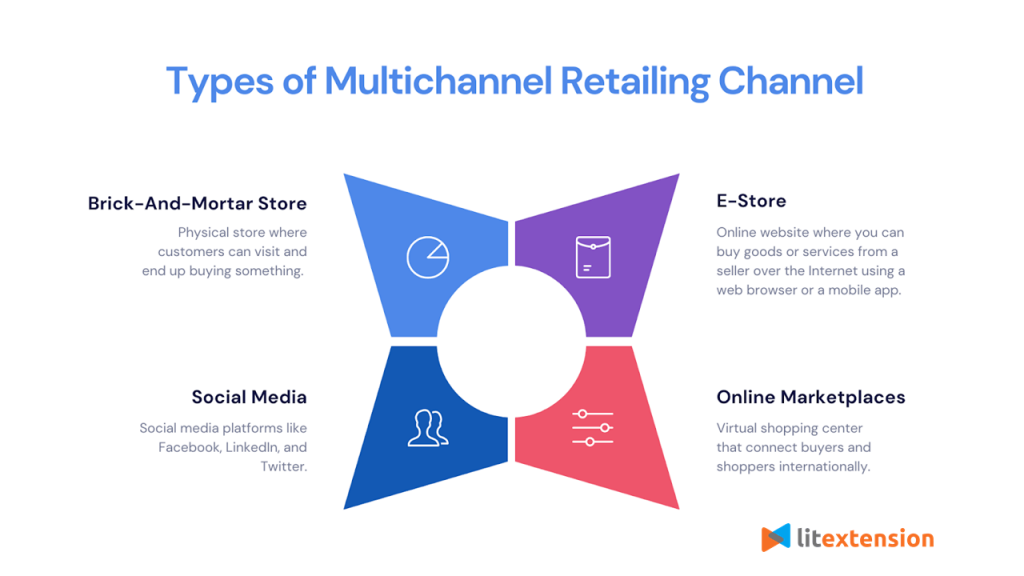
Without a doubt, selling in multichannel brings a huge opportunity for you to make more money and level up your business. With that in mind, let’s go ahead and find out 4 types of multichannel retailing that you can pick up for your store.
1. Brick-and-mortar store
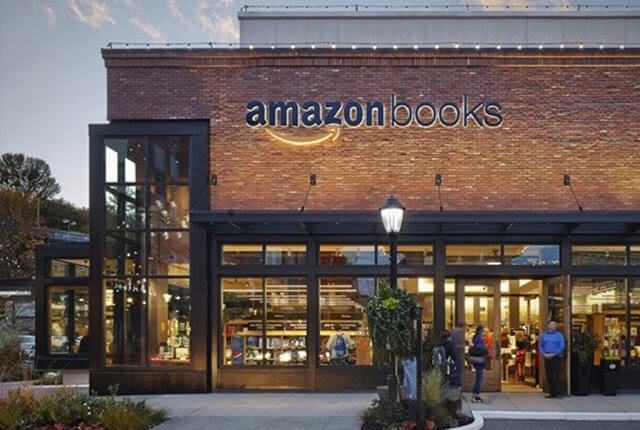
The term brick-and-mortar references the material from which physical stores are usually made. Instead of selling online, a brick-and-mortar store is often located in a building so customers can visit and end up buying something. Obviously, a physical store will easily earn trust from shoppers since buyers can see, touch, and try on merchandise.
Many merchants choose to combine an online presence with a brick-and-mortar store. A website can help to reach more potential customers, and also allows them to preview the product before purchasing at your physical store. Brick and mortar stores can now easily promote their online presence with a few marketing tricks like a dynamic QR code offers a flexible, environment-friendly, and economical solution to combine offline and online presence for your customers and update engaging and interactive content for them without the need to generate an entirely new QR code.
2. E-store
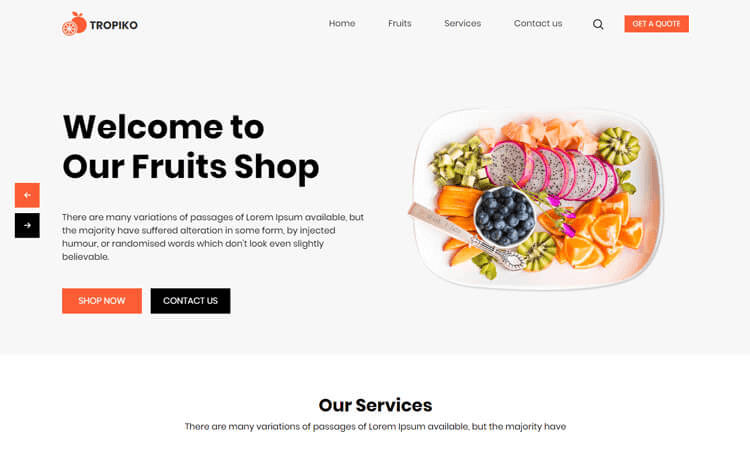
eCommerce stores are one of the most common channels to sell online. It allows consumers to directly buy goods or services from a seller over the Internet using a web browser or a mobile app. Besides, they can also complete their payment online and have the product shipped to their address. This way, the whole customer purchasing journey happens on your website. With an eCommerce platform such as Shopify, WooCommerce, Magento… you can easily create, customize, and manage your own online store.
An E-store can be easily integrated with different channels such as eCommerce marketplaces, social media, or even with other online stores. This makes things easier than ever for an e-merchant to implement its multichannel retail strategies.
3. Online marketplaces
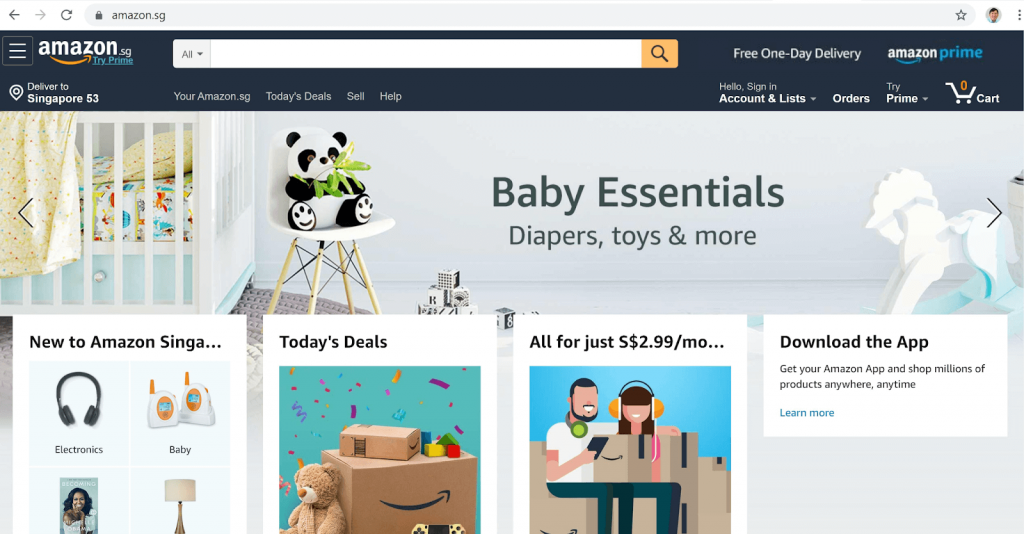
A marketplace is a business model which connects sellers and buyers from all over the world together. Unlike a store owner, a marketplace merchant will leave most of the marketing and operations jobs for the marketplace to take care of so they can focus more on promoting their brand as well as driving more traffic.
Moreover, when purchasing from a marketplace, both shoppers and sellers will be bound by the policy of the marketplace. Hence, it’ll be much more transparent for both sides in the purchasing as well as the payment progress.
eCommerce marketplaces like Etsy or eBay have a huge potential to integrate with your online/offline store, social media, and so on. Also, it’s quite easy to connect a marketplace to your available selling channel. Hence, It’ll be easier for you to make your first step in building your multichannel retail business.
4. Social media

Social media channels are places where you can connect and engage directly with your target sales prospects using social media platforms like Facebook, Linked In, and Twitter. One of the biggest functions of this channel is to build strong and trusted relationships with your customers. It‘s easier for you to get closer with shoppers since social media is more personal than other channels. Besides, your potential customer will be more likely to see you as an expert and an authoritative figure in your field if they see you’re active on social media.
Just like an eCommerce store, you can also include your Facebook store or Twitter into the selling system to create a multichannel retail store.
Multichannel retailer examples
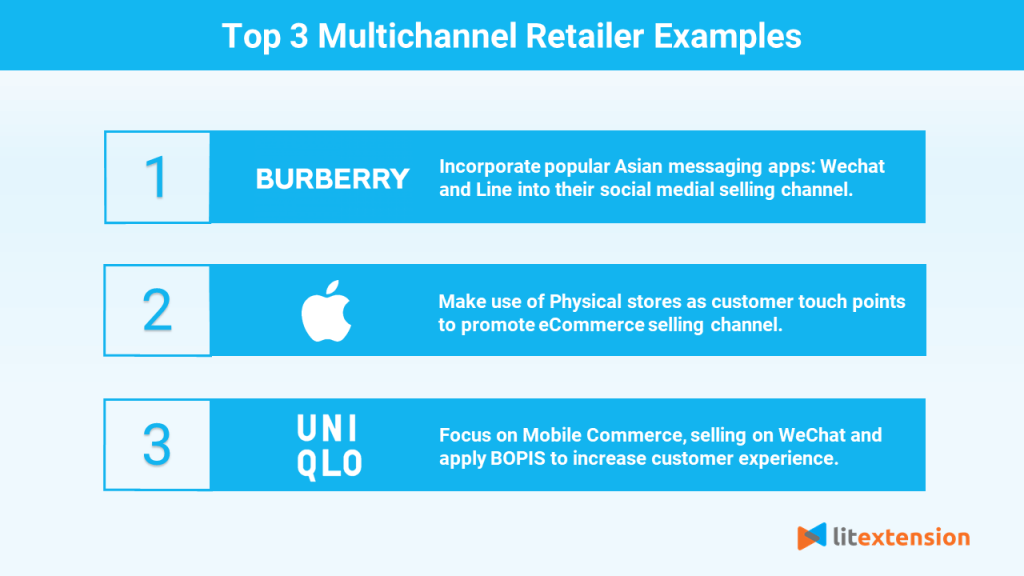
1. Burberry

Let’s get started with a fashion business which is super famous in Asia – Burberry. It’s a luxury fashion house headquartered in London, England which designs and sells coats, leather goods, footwear, fashion accessories…
Burberry has gained a solid position in the fashion retailing market in some Asia countries such as China or Japan by using its social media channels. Besides Facebook and Instagram, this fashion business has incorporated both of these popular Asian messaging apps: Wechat and Line. Live-streaming and real-time engagement with its fans by social media channels are one of the best strategies to help Burberry’s brand become famous within its target markets.
Along with that, Burberry is also making use of the marketplace selling channel including Alibaba’s Tmall in China – the largest business-to-consumer (B2C) retail platform in Asia. Besides, Burberry applied a Buy-Online-Pickup-In-Store system that helps streamline the customer experience and cut down the delivery time.
2. Apple
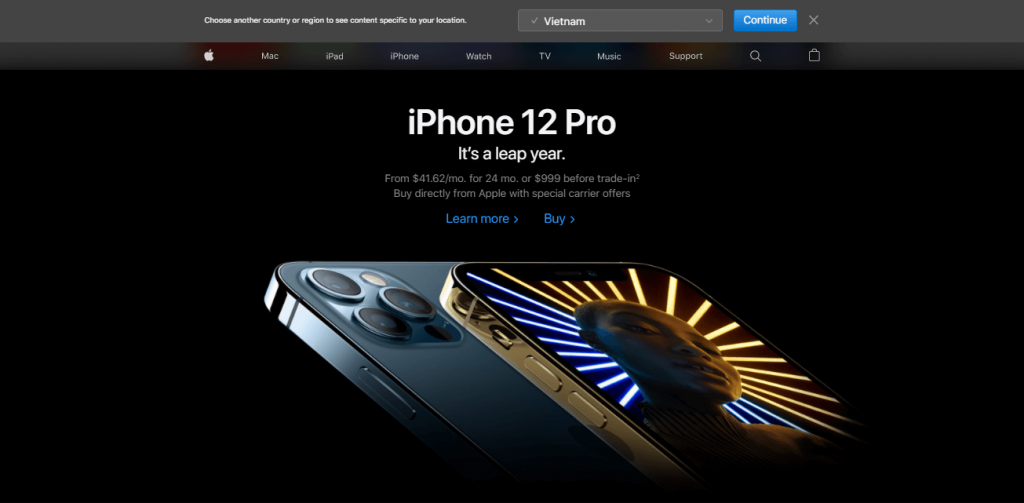
One of the greatest examples of successful multichannel retailers is Apple. The company has turned Apple into a worldwide brand with its multichannel retail strategy… Apple operates on both physical and online stores as its two main selling channels.
However, rather than focusing on selling on their brick-and-mortar store, Apple’s physical store is designed to promote the eCommerce channel. This way, the core function of an Apples’ physical store is to gain brand awareness as well as to support the overall customer experience. As a result, Apple’s online store will be the channel that accounts for the majority of total sales.
One more thing that should be noticed in Apple’s multichannel strategy is the consistency of branding messages within its selling channels including website, apps, services, and retail stores. They all have the same visual style and design language. Hence, you can always tell it is an Apple product when you see one.
3. Uniqlo
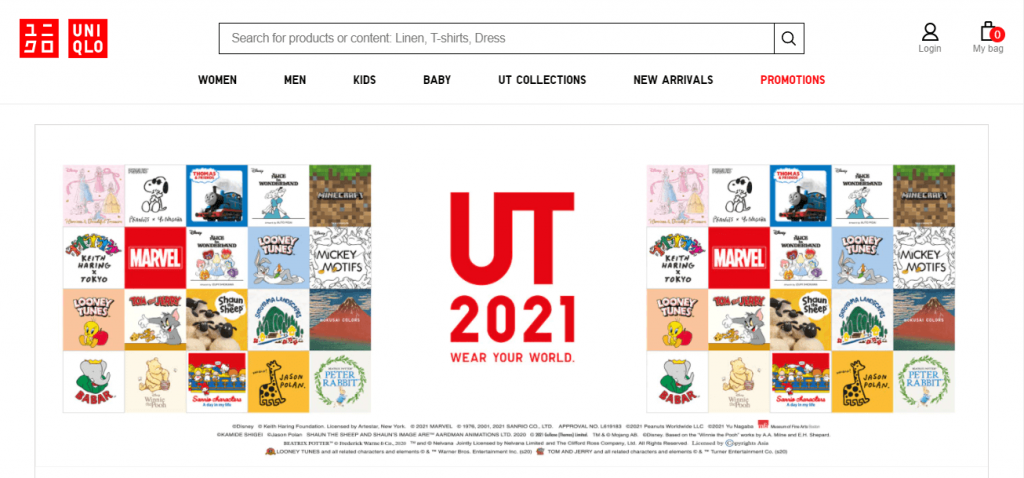
Uniqlo is a fashion retail brand that sells globally and is quite famous in Asia. The Japanese company is a great example of successfully implementing multichannel retailing to enter competitive markets such as India or China.
In China, where mobile Commerce plays a central role in the multichannel customer experience, Uniqlo was one of the first fashion brands to embrace a virtual dressing room when it launched its Uniqlo Magic Mirror in 2012 to engage more customers for its social media channel.
Uniqlo’s “Style Your Life” campaign in 2014 has gained more than 600.000 followers in just 6 months. The in-store shopper could try outfits virtually in front of a screen with different backgrounds and send back the picture by adding their WeChat and follow Uniqlo. Also, Uniqlo used WeChat as a social media channel to connect with customers and send them coupons or promotions.
2. Benefits of Multichannel Retail
Boost your revenue
Going multichannel means more sales revenue. You will get into more areas of the market and get new customers. Therefore, you’ll have a great opportunity to make more sales.
More retail channels also give you additional tools for upselling. From implementing advertisements at your physical shop to displaying personalized recommendations on your eCommerce website. Moreover, you can also use social media to promote your brand on the go just from your phone.
Gather insightful data to help understand consumer behaviors
“We’re not in an information age anymore. We’re in the information management age.” – Chris Hardwick.
Indeed, all the traces left by customers when purchasing from your multichannel store is the key for further investing and finding the right way to dig in. Multichannel retailing allows you to collect a wide range of customer data to help you build a profile of your audience.
To be more clear, from your analytic center, you can have a greater degree of visibility among various demographics, purchasing history, interests, as well as the time, location and device they shop from. Hence, it’ll be much easier for you to understand your shoppers and make better decisions.
For example, your store sells handmade items and second-hand products on 2 main channels: eBay and Etsy. After several months, you notice the total sales on handmade items from Etsy has increased rapidly while in eBay, this number was on a downward trend. On the other hand, on your eBay store, the handmade product is quite hard to sell while second-hand products sold out in just a few weeks.
Evidently, there’s a high chance that eBay is a good place to sell second-hand products and the handmade items should go with Etsy. It’d be wiser to raise your Ads budget for the second-hand products on eBay and for the handmade products on Etsy.
Create multiple channels to fit different kinds of products
Each sales channel has its kind of customer targets, hence it’s advisable to sell based on your channel’s needs. For example, Etsy – an online marketplace that is best suited for listing hand-made or vintage items while Ebay – a famous multi-vendor platform is a wise choice if you intend to sell a variety of items, from antiques and gently used items to brand new ones.
3. Multichannel Customer Behavior
Consumer behavior represents what, why, when, and where they purchase your products or services. Customer behavior has a dynamic nature that changes continuously. Therefore, It’s crucial to continually monitor your shopper’s behavior in order to gain knowledge about their customers’ needs and act upon them.
According to Internetretailing, multichannel shoppers spend 82% more in each transaction than in-store customers. That being said, it’s not easier to attract this type of consumer. Multichannel customers are more engaged and better informed. Before making the purchase, they’ve seen the product on many channels read reviews, and guides. They are confident that it’s a good deal which will eventually motivate them to buy more.
To get a better understanding of your buyers during their purchase journey, let’s dig deeper into the cause of their activities such as their driver (what makes them buy from multichannel stores?) and their Inhibitors (What makes them leave multichannel stores?).

The driver of multichannel shopping
- Time savings: E-services create an enormous advantage in terms of time-saving. With multichannel retail, customers can easily find what they need and buy it from their favorite channels. They could come to your physical store or have it shipped to their address. Hence, less time is taken for the products to get to the buyers, which is one of the key benefits that make them love a multichannel brand.
- Globally purchasing: Many shoppers choose a multichannel store for the freedom to order anything globally from locations within and outside of the consumer’s residency. This is a big strength of multichannel stores. Customers love to buy goods from different countries even if it takes more time to ship.
- Brand awareness: Your brand plays a vital role in customer experience as well as their process of deciding which brand to buy from. With multichannel selling, shoppers will choose the brand with more credentials and better engage with them. Once you have their trust, converting will never be easier.
- Wider choice: E-services enable consumers to reach out for newer, novel goods, and more types of products from their social media, marketplace, or your website. More choices mean better chances to get suitable items, this is also one of the main reasons to make shoppers more interested in buying from multichannel stores.
- No incidental costs: Online shopping and multichannel retailing reduces or eliminates incidental costs associated with traditional shopping, such as driving in traffic congestion or inclement weather or waiting in queues.
Inhibitors of multichannel shopping
- Technology literacy: The lack of sufficient skill to operate and manage online websites is still a major consideration for consumers. Many consumers can be intimidated and consequently, they’ll back down from buying from you.
- Limited information on quality and service: As mentioned above, multichannel customers will consider nearly everything before getting to the purchase. Hence, you need to keep them informed at all times. Make sure every product is filled with information that would benefit buyers.
- Shipping, delivery costs: Consumers often hesitate to buy a product because of perceived time delays in shipping and delivery, or sometimes, the shipping cost is too high.
Multichannel buyer’s journey
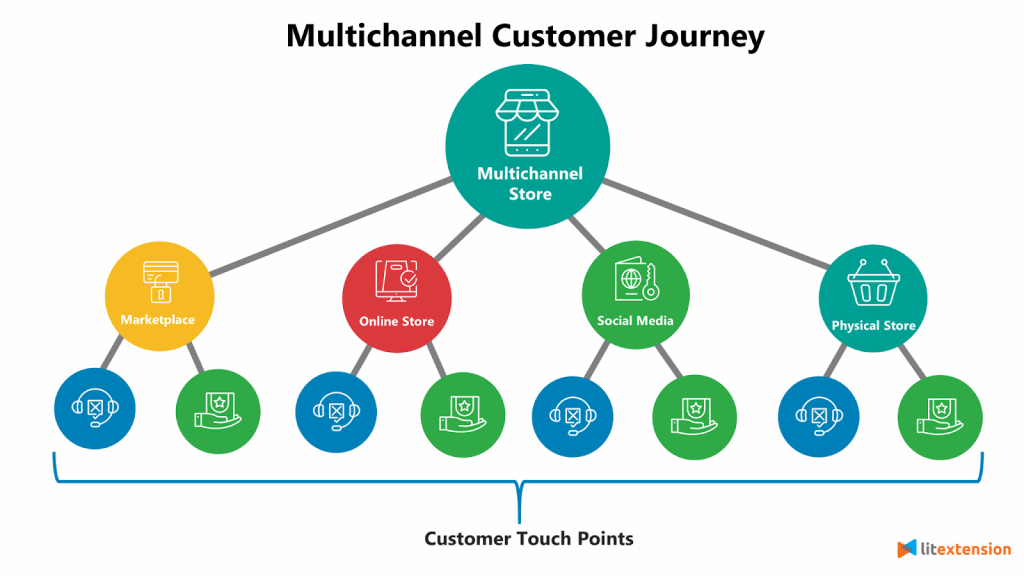
In general, opening a multichannel store means taking advantage of various selling channels to broaden your customer touchpoint. In parallel, it provides customers with more than one source of information about your product including price, type, attribute, description, and so on. As a result, you offer more choice and reduce the time for your customer to find what they need.
Here is an infographic describing an on customer journey on a multichannel store:
Apparently, you need to focus on building your multichannel retailing strategy. All your channels should support each other to influence customers to buy from you and come back next time. Here are a few factors that make shoppers consider your multichannel store reliable:
- The ability to access a variety of the same kind of goods.
- Convenience when browsing across all channels of your store.
- The availability of search for the lowest price.
- Full information about the product.
- The assurance of security.
4. Technology Solution for Managing Your Store
Famous selling channels
Here is our recommendation on some of the best selling channels available on the market:
- eCommerce platform that bests for building your E-store:
Open-Source solution: WordPress, WooCommerce, Magento, OpenCart, and Prestashop
Hosted solution: Shopify, BigCommerce, Squarespace, Weebly
- Marketplace for listing your product: Amazon, Etsy, eBay, Facebook Shops, and Google Shopping.
Synchronize all of your channels
Because of the diverse selling channel, a multichannel E-store is harder to effectively control and manage. From inventory tracking, fulfilling orders, managing information to forecasting future trends. To do so, you need to get a multi-channel selling tool that best suits your business.
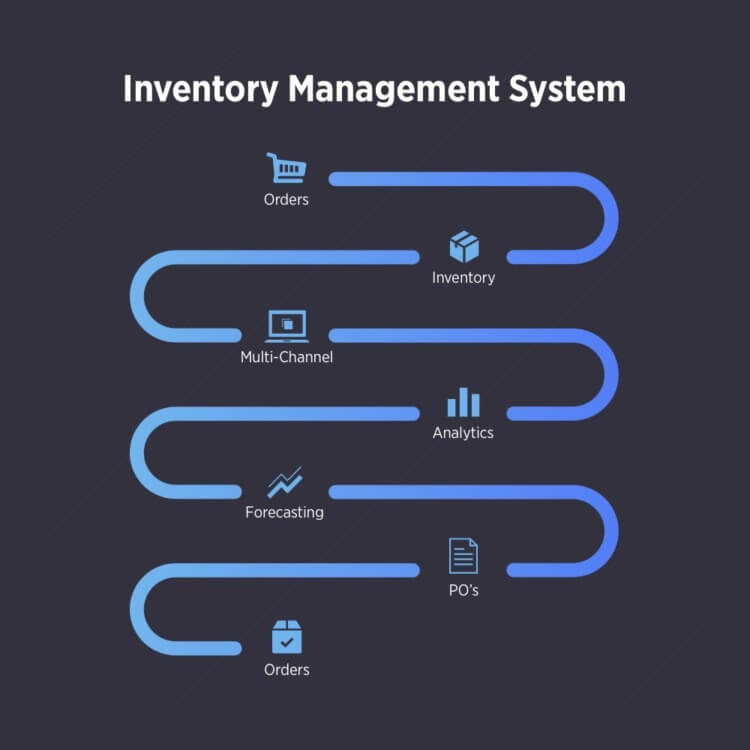
With reasonable pricing and extreme ease of use, LitCommerce is proud to be one of the most suitable multichannel selling tools for SMBs. LitCommerce gives you the most advanced features to effectively list and manage your products on multiple sales channels such as marketplaces or shopping carts, all from a single dashboard. If you need more information, please contact the 24/7 support team, they’re always ready to help.
5. Final Word
Multichannel retailing is the future of the retail industry and it is going to expand. We have gone through the definition and benefit of multichannel retailing, customer behavior from the beginning to when they complete the purchase, and some technology to support your system. I hope you can get the solution to all your concerns in this article.
If you like to read more and get new tips about the eCommerce world, join our social community now!
Good luck!